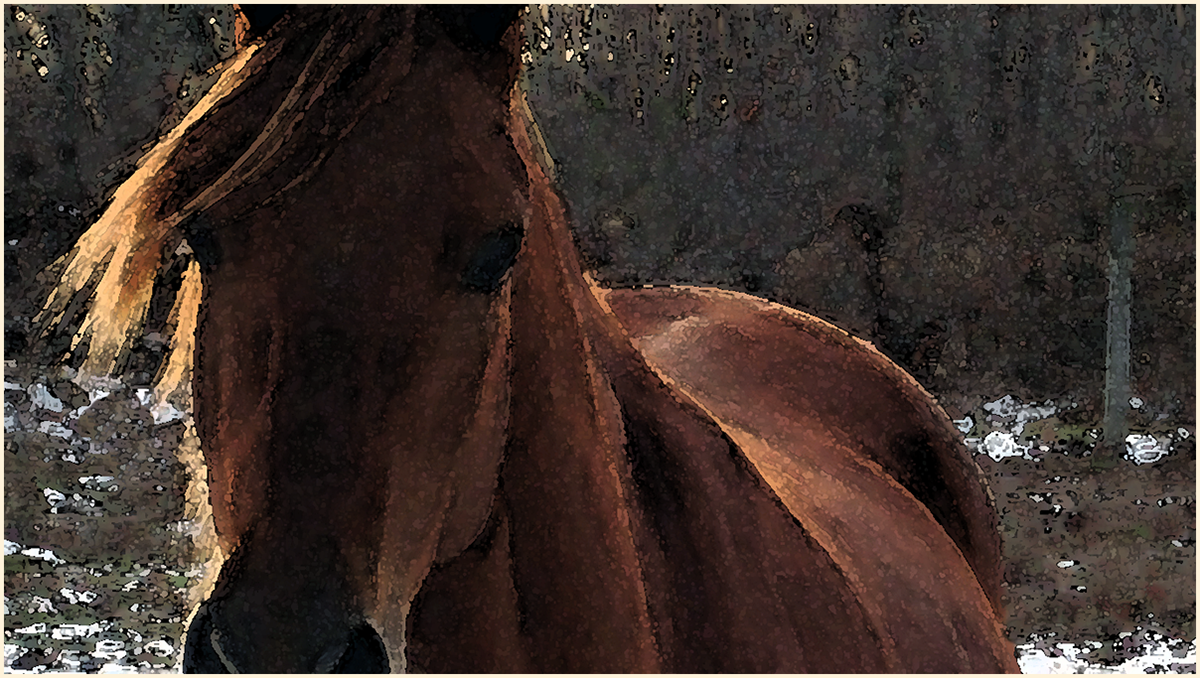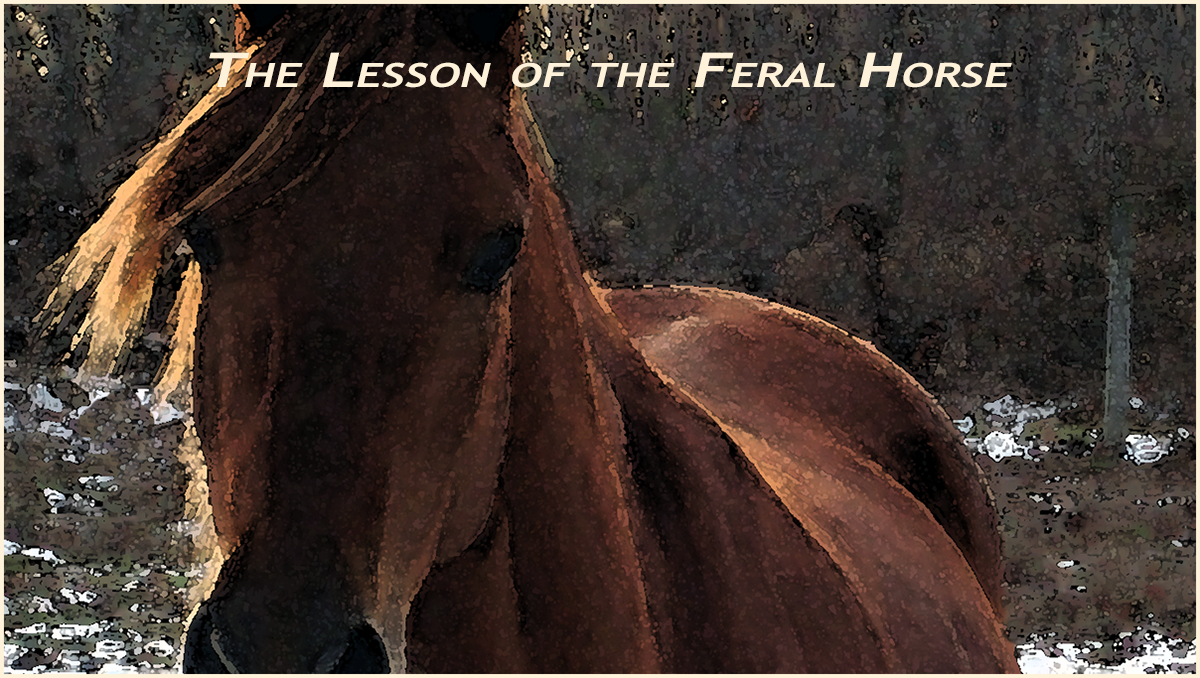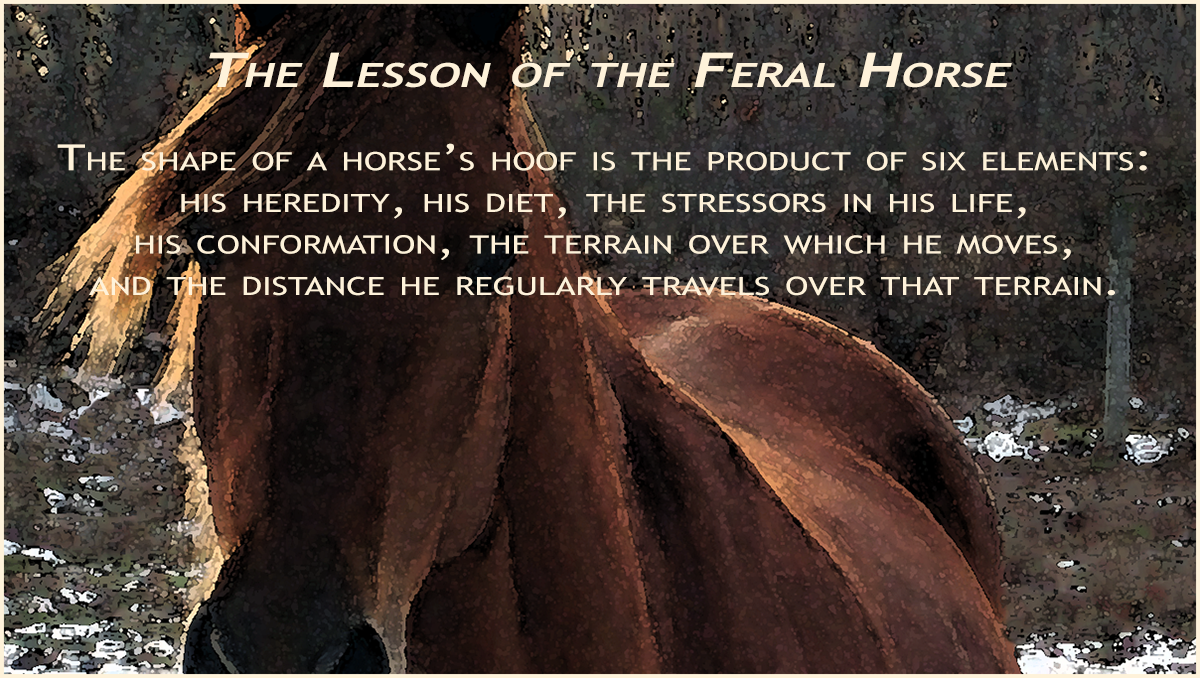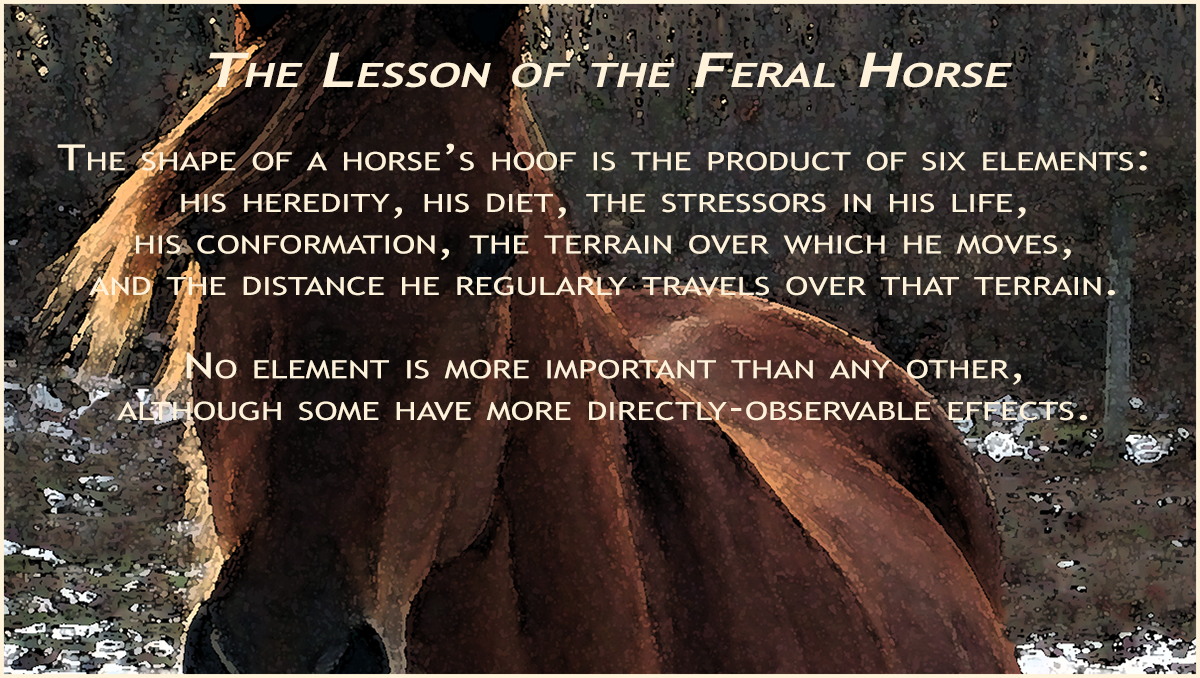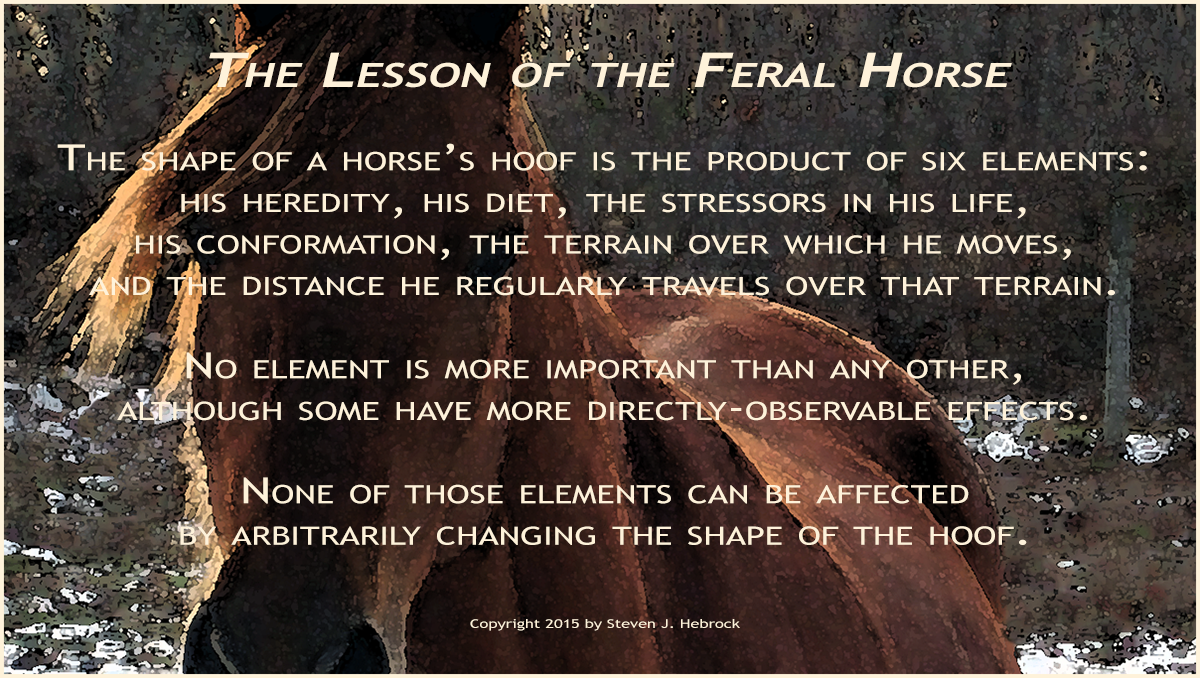I had to laugh. One of my clients was recently recounting the resistance she faced from other boarders after making the decision to pursue natural hoof care with me. “And I hope you’re not paying extra for that ‘mustang roll,'” one woman said. “Any farrier can do that!”
Her story ended up coinciding rather nicely with the theme of this particular article. My goal in writing has always been to correctly explain why hoof care based solely on the lessons provided by nature – in other words, “natural” hoof care – is, logically, the only possible approach to caring for every domestic equid’s feet. But a reader’s response to my recent Unnatural Practices article, reinforced by my client’s story, made me realize that my assumption everyone was grasping a very fundamental piece of the hoof care puzzle without my directly stating it was quite probably flawed. After all, you know what they say about assumptions! And that makes this article long overdue, for which I sincerely apologize.
The reader’s comment dealt with the relevance of Jaime Jackson’s observations of the feral mustangs of the U.S. Great Basin to the hooves of her domestic horses – specifically, how she failed to see any. And that’s a very important question that deserves an explanation. Why? Because the apparent differences between feral and domestic horses are often used by skeptics and critics, who really don’t understand how the two are connected, to dismiss the entire concept of natural hoof care outright. And because understanding the answer will also give you insight into a great many things about how our world works. So regardless of what you currently believe to be correct about hoof care, it’s in everyone’s best interest to thoroughly understand the answer to her question.
The answer turns out to be remarkably simple; in fact, it can be summed up quite accurately in a single word! But let’s first state the question in a reasonably-complete form –
Question: What do the hooves of the feral horses of the U.S. Great Basin – who live in an arid and abrasive environment; eat dry, bunch grasses and other indigenous plants; and aren’t ridden – have to do with the hooves of my domestic horses – who live in confinement in a much wetter environment; eat various types of hay and processed feeds; and are ridden or driven?
Answer: Everything.
“Ok, Steve,” you’re probably thinking. “Not very helpful. Way too Yoda-esque!” But give me a few minutes, and hopefully you’ll see why I responded as I did.
First, though, permit me to caution you: many of you are going to face genuine difficulties with my explanation because, as humans, we all have certain subjects – usually ones we’re very passionate about or otherwise heavily invested in – we’re unwilling or unable to be objective about because of education, experience, and/or peer pressure. We see and hear what we want and need to see and hear, and close our minds to other possibilities. Close our minds to the idea that we may, in fact, be mistaken. And that’s just human nature; we all view the world through our own set of “glasses.”
This seems to be very much the situation when it comes to challenging traditional points of view in the horse world. For example, when I first began teaching hoof care at the university, students would often ask questions like, “What does this type of horseshoe do?” And I’d answer with, “Well, it’s generally believed that it (fill in the blank), but studies have shown it has no real effect on that particular characteristic.” And then the student would be angry with me, because the data conflicted with his or her view of the world. So I’m well aware of the difficulties with asking people to see things from a new perspective. Nevertheless, I’m going to attempt a clear, thorough, and logical answer; I only ask that you, in turn, attempt to put aside any and all preconceived notions you may have about hooves. And also please remember that I’m trying to help, so don’t shoot the messenger! Here goes…
The traditional view of hoof care, as endorsed by nearly every veterinarian and farrier as well as a great many so-called “natural” hoof care providers, is one based not only on shapes and numbers, as I pointed out in Unnatural Practices, but also – and most significantly – one where hoof form is viewed as the means of causing proper movement. Many volumes have been written on this subject, filling page after page with trimming and shoeing methods that emphasize trimming to particular forms and dimensions for “making” horses move in particular ways or for “correcting” “deficiencies” in conformation and movement. Here are a few examples from The Horse – Second Edition, by J. Warren Evans –
In the base-narrow, toe-in fault in foreleg conformation, the foot breaks over and lands on the outside wall, and if the horse is unshod, the outside wall will be worn down. It is necessary to lower the inside wall to level the foot, and then several corrective measures can be used to force the foot to break over the center of the toe.
Horses with a base-wide, toe-out conformation tend to break over and land on the inside toe. The fault is corrected by modifying the shoe to make it difficult for the foot to break over the inside toe but easier to break over the center of the toe.
Cow-hocked horses tend to break over the inside toe and thus place a strain on the inside of the hock….The main objective in correcting the fault is to force the hind foot to break over the center of the toe by braking the inside of the hoof when it lands and rotating the toe inward.
Consequently, this ends up being the usual mindset of the horse owner as well: hoof care providers can and do “create” either good or bad movement by how the hoof is trimmed. So when “natural” hoof care came along, many people (naturally!) applied this same pattern of thinking to it, equating “natural” hoof care with the feral horse hooves’ physical characteristics such as the “mustang roll” or the toe angle. And, because of this type of thinking, they reasonably assumed feral hoof form would not be of benefit to, or perhaps even be harmful to, the desired movement of their domestic horses; hence, the comments of my reader and my client’s fellow boarder.
The problem is – and please listen carefully – the traditional understanding of hooves and hoof care is seriously flawed at its most fundamental level.
So now I’ve said it. And probably many of you can already feel the adrenaline rising as you prepare to argue the point. But please hear me out!
You see, contrary to what you’ve heard or read or thought, “The Lesson” of the feral mustangs is not about the way their hooves look. It’s not about the “mustang roll.” Or how much concavity they have. Or how short their hooves are. It isn’t about any of those things, or any other specific physical characteristic. And yet, it’s also about all of them.
In reality, “The Lesson” of the mustangs we were given through the work of Jaime Jackson is about cause and effect. It’s about understanding that hoof form is merely the effect of several different things, including movement, but is never the cause of correct movement. When we see a group of feral horses, whose hooves have not been shaped by people, we’re seeing the pure product of genetics, diet, stress, conformation, environment, and movement. These factors work in concert to produce the ideal hoof form for that particular horse – without any assistance from us. Indeed, from the moment a foal is first conceived, these elements begin to shape the hoof into its best possible form. And when one or more of those elements changes, such as the horse begins to be ridden, the terrain becomes wetter, or the foal starts walking with the herd, the hoof form will reflect those changes as well. So it makes no difference whether it’s a feral mustang or a domestic grade horse, the forces that determine hoof form are exactly the same for every horse.
And once you come to terms with this list of elements as the only determining elements in hoof form, the next logical conclusion that follows from it is this:
Changing the hoof’s shape cannot possibly change any of the causes of the hoof’s shape.
Look at the list. How could I hope to significantly affect any of them through trimming? Shape doesn’t determine shape – that makes no sense! Does anyone seriously believe, for example, that putting a tire of a particular shape on a bent axle will straighten the axle? And yet, we blindly buy into the notion that a horse’s conformation or genetics can be altered by changing the shape of his foot.
Why is that?
I realize it’ll probably take a while for all of this to sink in, but the truth of proper hoof care is actually quite simple: we cannot – ever – improve upon a horse’s movement, and therefore his hoof form, beyond what he’s already capable of if he were left to his own devices under suitable circumstances. Period. People can only stand in the way of good movement by creating trimming or shoeing out of harmony with those six elements I mentioned, because those forces are absolutely relentless.
Consider the example of a horse with one front foot more upright than the other: assuming he’s been properly trimmed thus far (admittedly a big assumption), making his hoof angles match through trimming will not accomplish anything, because the forces that caused the more upright foot are still at work and cannot be mitigated through trimming. And so, with every step he takes, his body will be “fighting” the trim, making his movement worse, not better. Think of it like skipping rope: the rope can continue to turn normally only as long as the jumper is in harmony with its movement. But as soon as the two get out of sync – disaster!
So that’s “The Lesson” of the feral mustangs. The “wild horse model” is not about a particular hoof form – it’s really about understanding the forces at work that result in every hoof form. And what they’re teaching us is that the traditional approach, as well as many so-called “natural” methods, espouse hoof care that’s “bass-ackwards,” as my mother used to say!
Proper hoof care, which can only be based on the laws of nature (physics and biomechanics, if you prefer), comes down to having a solid grasp of three things: 1) understanding hoof form cause and effect, 2) understanding what constitutes proper hoof form for a particular horse at a particular moment in the horse’s life, and 3) knowing how to allow that hoof form to emerge by trimming in a manner consistent with the six elements I’ve described. Any other approach can, at best, only impede proper movement and limit your horse’s potential, and, at worst, cause irreparable damage to joints and bones.
Does your hoof care provider understand?
